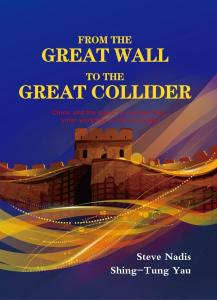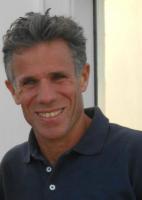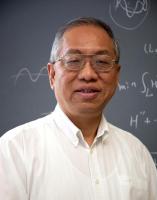Yau/Nadis: From the Great Wall to the Great Collider
CHINA AND THE QUEST TO UNCOVER
THE INNER WORKINGS OF THE UNIVERSE
Steve Nadis (NASW member) and Shing-Tung Yau
International Press, October 23, 2015, $29.50
ISBN: 9781571463104
Nadis reports:
My involvement in this project grew out of a multiyear writing collaboration I’ve had with Shing-Tung Yau, a Harvard mathematician whose work is closely entwined with physics. Yau told me about plans to build the world’s largest particle accelerator in China, a possible successor to the Large Hadron Collider in Geneva, Switzerland. Having written about physics, astrophysics, and cosmology for more than three decades, I sensed that China’s “Great Collider” could make a great story — one that might appeal both to Western and Asian readers.
We chose a Boston-area academic publisher, International Press (IP), for several reasons. Because of my coauthor’s close ties to IP, we didn’t have to write an elaborate proposal. IP could turn out a book extremely fast, going from page proofs to bound copies in less than two months. IP also arranged for a Chinese translation, opening up a potentially big market.
I spent two weeks in China in August 2014, a trip arranged through the Institute of High Energy Physics (IHEP) in Beijing. IHEP made sure that my days were packed: I met with dozens of physicists and toured numerous facilities, including an electron-positron accelerator in Beijing, an underground neutrino experiment outside of Hong Kong, and a potential Great Collider site near the East China Sea. Some of my workdays went from 6 a.m. until 10 p.m., which was hard for a long-time freelancer who is used to setting his own schedule. The really hard work did not begin until I returned to the United States, when my coauthor and I had to figure out how to shape the material I’d collected in China — and more — into a book. This is the most creative part of the endeavor, as well as the part I find most intellectually challenging. Our manuscript was largely complete nine months later. We sent it to IP in June and, after editing, it went to the printers in September.While the book describes the Chinese proposal in some detail, the most important part of the discussion, in my view, concerns the exciting science that could be done at a facility of this scale.
Contact info:
- Steve Nadis, 617-876-7143, stevenadis@comcast.net
- Publicist: Aileen McElroy, 617-623-3826, aileen@intlpress.com
- Book websites: http://thegreatcollider.com; http://intlpress.com/site/pub/pages/books/items/00000450/index.html
NASW members: will your book be published soon? Take advantage of this opportunity for shameless self-promotion. Submit your report for Advance Copy.
Tell your fellow NASW members how you came up with the idea for your book, developed a proposal, found an agent and publisher, funded and conducted research, and put the book together. Include what you wish you had known before you began working on your book, or had done differently.
See https://www.nasw.org/advance-copy-submission-guidelines.
Thinking of writing a book? If you are a NASW member, you may access a list of more than 150 books and online resources to help you craft your book proposal, find an agent and funding sources, negotiate your contract, learn about self-publishing, publicize and market your book, and more at https://www.nasw.org/article/write-book.
Send book info and questions about book publishing to Lynne Lamberg, NASW book editor, llamberg@nasw.org.






